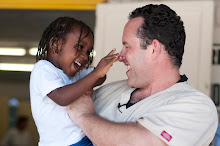Jay Tew recently returned to Haiti for a fourth rotation as lead clinician at Klinik Hanger. Following is his last blog post with reflections from Jay about the trip.
June 10, 2012
It’s time to depart once again. This time there is no one scheduled to greet the new person coming into Port-au-Prince; I am leaving and there’s no transition clinician to pick up the new person coming in. Joel realized this and asked if he could go and help with the new clinician pick up, “cause someone has to be there, right?” he says. I said, “Ok, that sounds like a good idea Joel, thank you”. The last I heard he is still making the Port-au-Prince run at 4am, headed over the mountain or down the coast to Port-au-Prince, greeting the new volunteer for Klinik Hanger.
I was there before the Klinik was built when Van (the founder of the Hanger Ivan R. Sabel Foundation and Haitian Amputee Coalition) introduced the mission and goal of the group. A sustainable clinic is the end result – send a focused group of professionals to a location in need, build a clinic, teach the people, and leave a sustainable clinic so the people of the land can continue to give care to their own in future times. Well Van, you did it. I couldn’t have dreamed it any better.
Thursday, October 18, 2012
Tuesday, October 9, 2012
Reflections from Jay Tew - 11
Jay Tew recently returned to Haiti for a fourth rotation as lead clinician at Klinik Hanger. The next several blog posts are reflections from Jay about his most recent trip.
June 8, 2012
This is a monumental day for Klinik Hanger and Hopital Albert Schweitzer (HAS). The rehab department led by David Charles has set up the first community outreach program. They have scheduled ten appointments with homebound patients in need of orthotic and physical therapy care. A group of us leave early in the morning including David Charles PT, a physical therapy assistant, Joel, Klinik Hanger technician, and myself. We head to the community of Leoncoeur through corridors, back alley-like roadways, and very rough terrain at times even hard for the land cruiser to pass. We have to head out on foot many times. We evaluate ten patients and head back with eleven casts. Our day lasted from 7am to 3pm. It was a long, hot day but worth every drop of sweat.
One of the best moments, and scariest for me, was our first patient visit. We got our gear and walked through alleyways to a cement-like structure of a home. The family helped bring out an older lady who was post-stroke with drop foot. I start placing our supplies out to cast for an ankle-foot orthosis (AFO) and as I remove the cast saw from the bag, it hits me like a freight train – there are no plugs here; we’re far away from any electrical source in this region. At this point I get cold chills (and it’s brutally hot); I’m trying to think what can I do. I still look at David and say with a quivering voice “guess there’s no electricity“. He just looks at me with a smile and says “no”. What an ignorant question but I had to try. Then I look to Joel and he says no worries boss I have my casting blade (utility blade that hooks away from patient to allow cast to be cut off safely). I cannot tell you how happy I was at that moment. I tell Joel he has saved the entire day my friend. He say’s “hey boss you always tell me be three steps ahead, so I bring it”. That was a great time and turning point for me because although I have had a great deal of time here, I still think like a foreigner at times. A Haitian practitioner understands the needs and situations best for their people; what the system is like and the needs once out of the protective walls of the clinic. I look at Joel and say, “Today is your day, I’m your assistant”. We evaluated everyone together and Joel applies and removes all casts today. I’m very proud to be here to assist the first Haitian rehabilitation community outreach program in this region we know of.
June 8, 2012
This is a monumental day for Klinik Hanger and Hopital Albert Schweitzer (HAS). The rehab department led by David Charles has set up the first community outreach program. They have scheduled ten appointments with homebound patients in need of orthotic and physical therapy care. A group of us leave early in the morning including David Charles PT, a physical therapy assistant, Joel, Klinik Hanger technician, and myself. We head to the community of Leoncoeur through corridors, back alley-like roadways, and very rough terrain at times even hard for the land cruiser to pass. We have to head out on foot many times. We evaluate ten patients and head back with eleven casts. Our day lasted from 7am to 3pm. It was a long, hot day but worth every drop of sweat.
Subscribe to:
Comments (Atom)
















